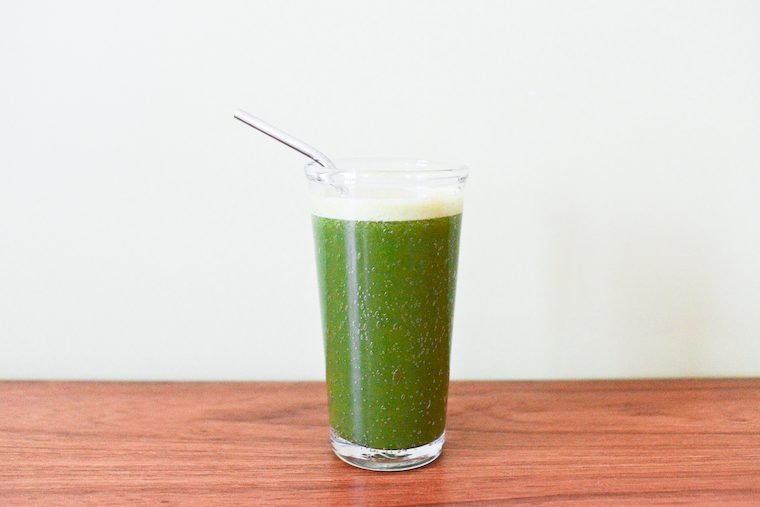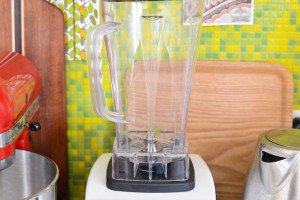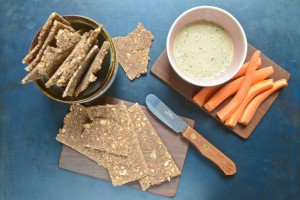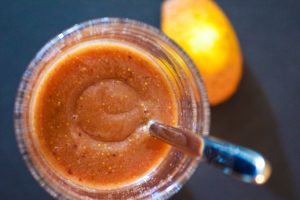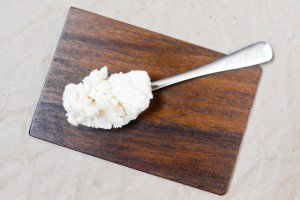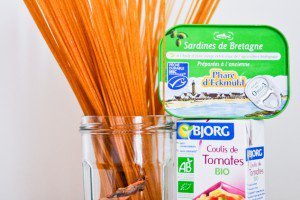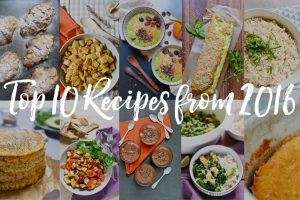I have been the proud owner of both a juicer and a blender for a while now. I’ve had a bit of a learning curve with both and I imagine I’m not alone, so let me pass along some of my best tips for juicing and smoothie-making.
If you want to report back on your own experience and share tips of your own, I would love for you to do so in the comments! I’ll be interested to compare notes with you, and other readers will benefit as well.
When is a good time to drink juices and smoothies?
My initial resistance in adopting juices and smoothies was this: I couldn’t quite see how they would fit into my daily eating habits. I wasn’t really looking to consume more food than I already was, and wasn’t too keen on trading any of my favorite eats (vegan lunch bowl, anyone?) for a tall glass of anything.
But! Those tall glasses quickly won me over and they are now most welcome, on three occasions in particular:
- Smoothies as a standalone breakfast, which I can sip on while getting ready for work, or sitting on the couch watching my kids punch each other — mostly in good fun — with my boxing gloves. (I took up boxing, people! It’s so fun! Have you tried it?) Because I add filling elements (see below), a 7am smoothie holds me over until lunchtime, even through pretty active mornings.
- Cold-pressed juices as a complement to my lunches. I love my weekday lunch bowls and they are typically vegetable-heavy, but some days it’s faster to make myself a quick sandwich, and round it out with a green juice.
- A smoothie or a juice is an amazing afternoon pick-me-up. It’s energizing and refreshing, and serves the double purpose of feeding and hydrating me.
I don’t, however, make it an obligatory or daily thing. Some weeks I crave them every single morning, other times I feel like eating other things instead. Or my schedule gets busier and I can’t get my act together to prepare them. It’s all good.
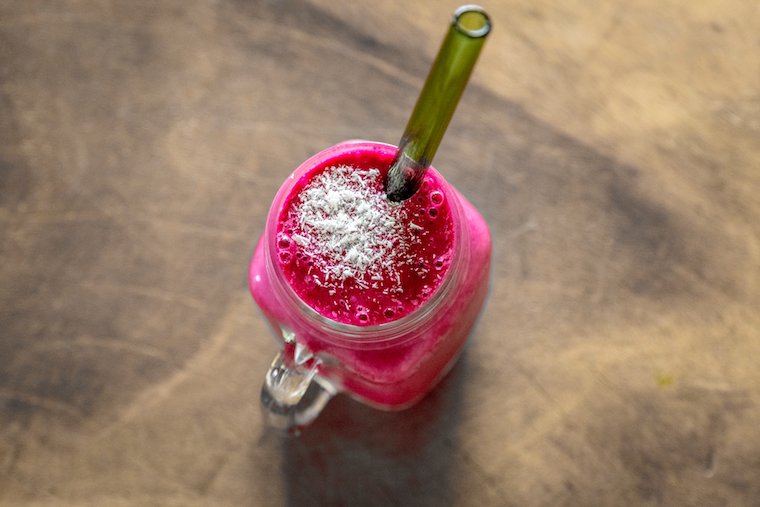
Do you need recipes for juicing and smoothie-making?
Let’s be clear: I don’t follow recipes.
I get a weekly basket of vegetables from a producer, so I just wing it using what I have and what’s in season, shooting for a 2-to-1 or 3-to-1 balance between vegetables (the focus is on them) and fruits (just enough to sweeten and round out the flavors).
In terms of produce, I typically draw from the following:
- Greens: kale, baby spinach, lettuce, beet or radish greens, various salad leaves
- Easy wins: carrots, beets, cucumbers, zucchini (these can do no wrong)
- Use sparingly (strong flavors, don’t overdo it): celery, radishes (pink, black, daikon), fennel, cabbage
- Herbs: parsley, chervil, mint, cilantro
- High-flavor roots: a tiny knob of fresh ginger or turmeric
- Fruits: apple, pear, kiwis, berries, stone fruits, grapes, banana (for smoothies only)
I also like to add some freshly squeezed lemon or lime juice, but that’s an extra step I don’t always take.
For smoothies, I also add a thickening ingredient or two to make the texture smoother: a banana, an avocado, or a big spoonful of nut butter or coconut butter.
I use chilled water as the liquid in my smoothies, and find the other ingredients are flavor-dense enough (especially the nut butter or coconut butter, and powdered superfoods, see below) that the result doesn’t taste watery at all. Coconut water or non-dairy milks are good options, but it’s rare that I use them.
Should you peel and trim the produce for juices and smoothies?
I use organic produce and don’t peel them; I only wash or scrub as needed. I do remove the stems and cores for smoothies, since they won’t be filtered out, but I leave them in for juicing (except for the stones and pits of stone fruits!).
As an organization trick for juicing, I clean all the fruits and vegetables before I begin, but only cut them into chunks as I feed them into the chute. This saves a little time, and also prevents me from overstuffing and jamming the juicer, which I tend to do otherwise because I am Jack’s complete lack of patience.
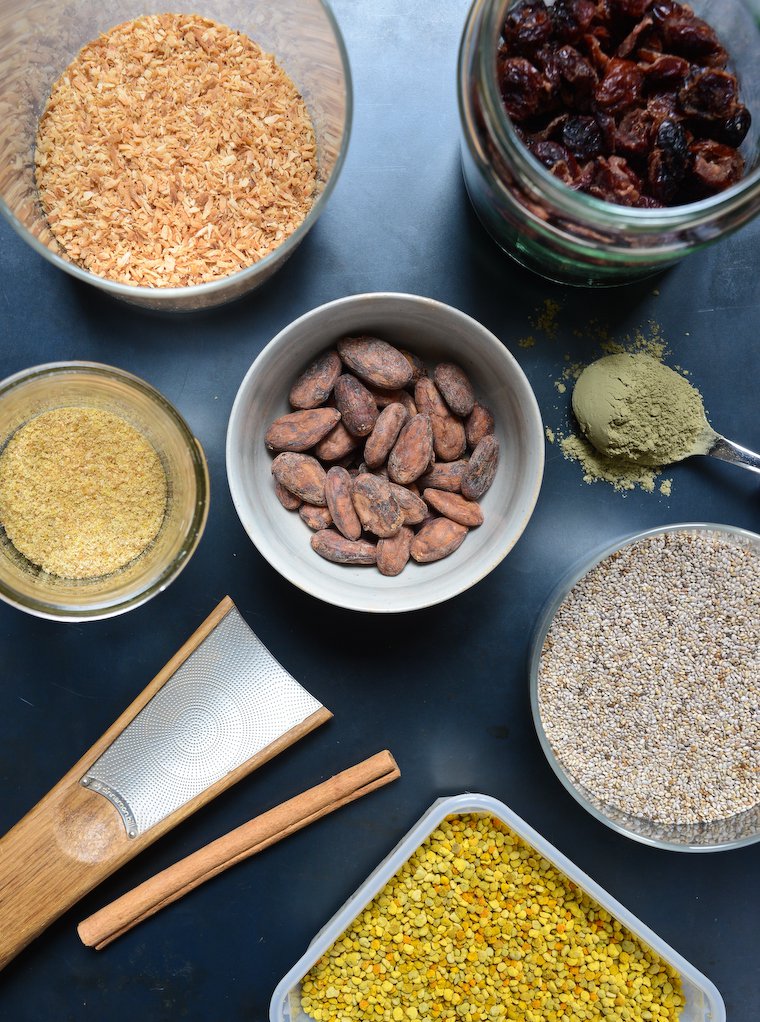
Can you use superfoods in smoothies and juices?
I got interested in superfoods through the excellent French company Sol Semilla, which imports high-quality and ethically traded superfoods in dehydrated and ground form. I always have a few of my favorites on hand, such as lucuma, açai, purple corn, carob or nopal.
I combine equal parts of the ones I have with some raw cacao nibs (or raw cacao powder) and chia seeds, shake to combine, and add a tablespoonful or so to my smoothies as a booster of texture, flavor, and nutrition.
(Note: If you want to try Sol Semilla‘s superaliments, use promo code CANDZ15 to get 15% off your order until November 1, 2016.)
Ugh, do you really need to save and reuse the pulp from juicing?
When juicing fruits and vegetables, the bulk of the nutrients go into the juice, and the pulp that remains is mostly fiber. There are many ways to make use of it — muffins, soups, pancakes… I commend people who do, or at the very least compost it, but so far it’s not happening for me. Some day perhaps. I don’t stress about it.
Is it okay to experiment? How do you deal with fails?
Because I don’t really use recipes and try new formulas every time, I try to note (in my head or in a notebook) my most successful combos so I can reproduce and build upon them.
Being willing to experiment also means that occasionally I make misguided decisions, like the time I insisted on adding ALL THE LEAVES from a full bunch of celery to my green juice. The result was barely drinkable. But it was so full of good stuff I didn’t want to throw it out. What did I do? I just used it as a base for a smoothie the next morning, with a banana and some raw cacao powder. Best smoothie ever! (PSA: make celery salt with celery leaves instead!)
Can you prep for juices and smoothies the night before?
If I want to pave the path for a morning smoothie, I prepare all the ingredients the night before. I wash and trim the fruits and vegetables, cut them into biggish chunks, and place them in an airtight container in the fridge.
I measure the superfoods powder, scoop out the nut or coconut butter I plan to use, and put them directly in the blender, since they’ll do fine at room temperature overnight. In the morning, barely awake, all I need to do is tip the contents of the container into the blender, add some chilled water, and pulse until smooth.
As for juices, the day-before prep simply involves selecting the produce I will use, washing and scrubbing as needed, and placing in a container in the fridge for easy access the next day.
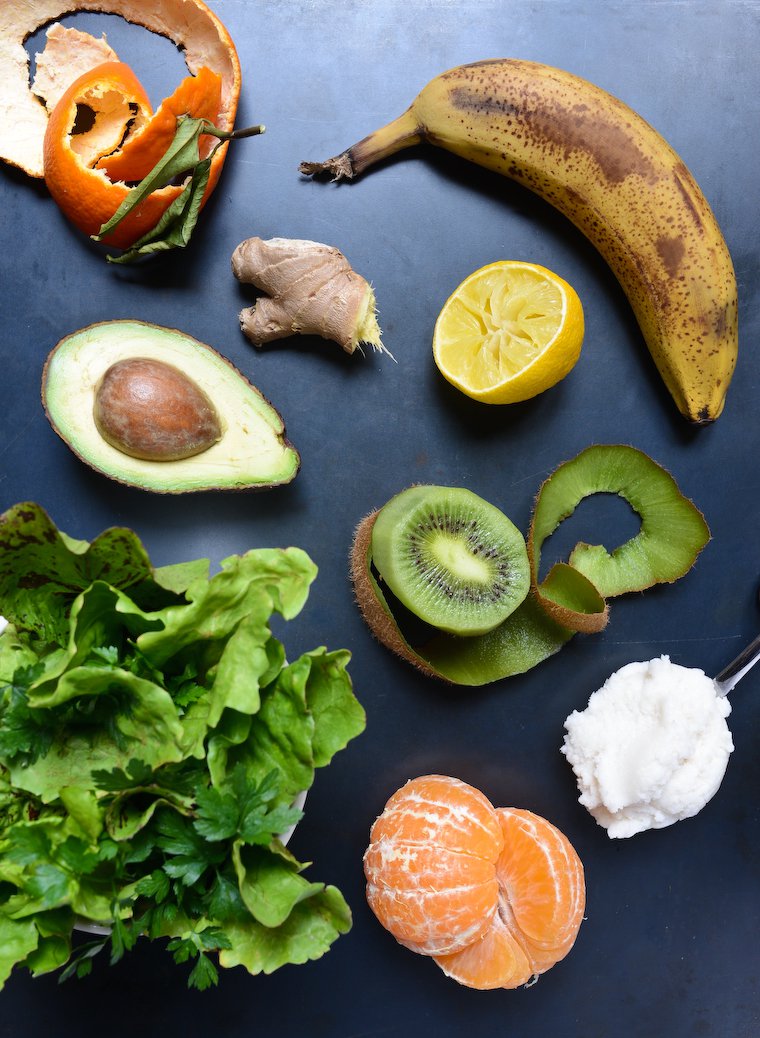
The ingredients for my Immune-Boosting Green Smoothie Bowl.
Can you make a big batch of smoothie or juice?
I always make more than I will drink right away, but no more than I can consume within a day or two at the most. I realize there is some loss of vitamins when a smoothie or juice has to sit around for a little bit, but they are still nutritionally beneficial (also: still delicious). And it’s the only way I can make it work in my life, so there’s that.
For smoothies, I make a double portion and use a container such as this one to store and refrigerate the extra serving.
As for juices, I pour the extra into a glass bottle, and use this vacuum pump (originally meant for wine, a fabulous little tool) to remove the air in the bottle, and limit oxydation.
Let’s talk cleanup!
I won’t lie. Cleanup isn’t the most seductive part of juicing. But I have found my own model (more about it below) to be fairly easy to clean. I have timed myself (sorry, is that dorky?) and, now that I’m used to the task, it takes me a little under 5 minutes to disassemble, wash, and set the different components out to drip-dry. Reasonable, no?
Cleaning the blender after making a smoothie is a much quicker process. To get as much as I can out of that tall jug, I use one of my beautiful tasting spoon from Earlywood, which have a long handle but a small bowl, and are therefore perfect for the job. Then, I just press a drop of dish soap into the jug, half-fill it with hot water, and run the blender on high for a few seconds. Pour out, rinse — you’re done!
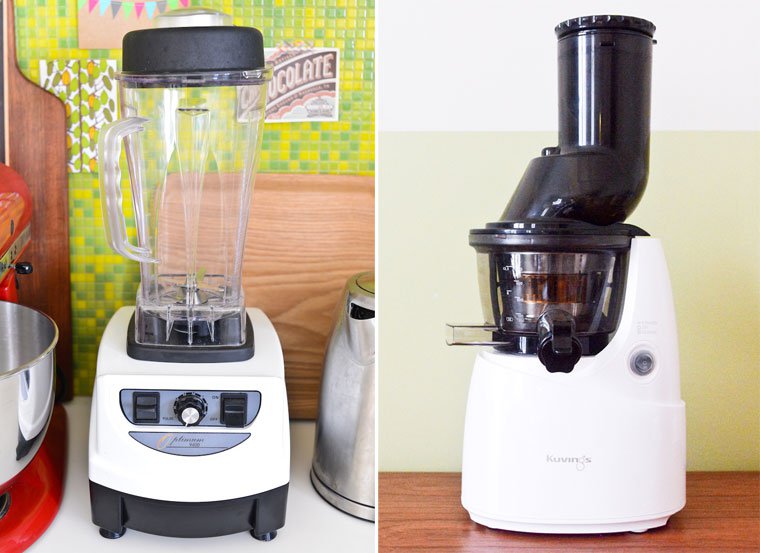
My Optimum blender from Froothie, and my Whole Slow Juicer from Kuvings.
About my high-speed blender
After years of yearning for a high-performance blender — to make really smooth soups, quick sauces and marinades, nut butters and milks, and of course smoothies — I finally got one. Based on my research, I picked the Optimum 9400 blender, distributed by Australian company Froothie, as an alternative to the better-known Vitamix or Blendtec. It’s a vortex blender that’s just as high-performing, if not more so, and the 2-liter (2-quart) jug works for both dry and liquid ingredients.
(I have been so happy with it I entered into a partnership with the brand and have a discount to offer. If you’re interested in buying a Froothie blender for yourself, use promo code CD-Optimum-Blender-20 to get $20 off your purchase of the Optimum 9400 or 9200A on the US store. The same code will get you 20€ off on the French site, the Belgian site, or the Luxembourg site. For my Canadian friends, the code is CD-Optimum-Blender-25 and you’ll get CA$25 off on the Canadian site.)
See also my detailed review of the Froothie Optimum 9400 blender.
About my cold-press juicer
After careful deliberation (sensing a pattern here?), I decided to invest in the Whole Slow Juicer, manufactured by Korean company Kuvings.
It is among the most performant “masticating juicers” of the market (commercial models notwithstanding), which means it yields a very high amount of juice, leaving behind pulp that is almost dry. It is super easy to use and pretty fast, with a chute that is wide enough to take large pieces (= less time spent cutting the produce = so important).
And because it is a vertical model, it takes up minimal space in our small kitchen — less than the average food processor would — so we can justify keeping it there and available for quick, near-daily access.
When I bought my Kuvings juicer, it came with two extra attachments: one to make smoothies (I use my blender for these, but it’s a good option if you don’t have one), and another to make instant sorbets from frozen fruit — think instant banana sorbet, but I’ve also used mangoes, berries, and even ice cream custard frozen in an ice cube tray.
Top 3 Resources
If you need to look at set formulas to gain confidence or to get your creative juices flowing, here are a few recommendations:
– The “Simple Green Smoothies” Instagram and recipe book,
– Cassie’s staple smoothies,
– Vanessa Simkin’s hot-off-the-press Big Book of Juices, and her website All About Juicing.
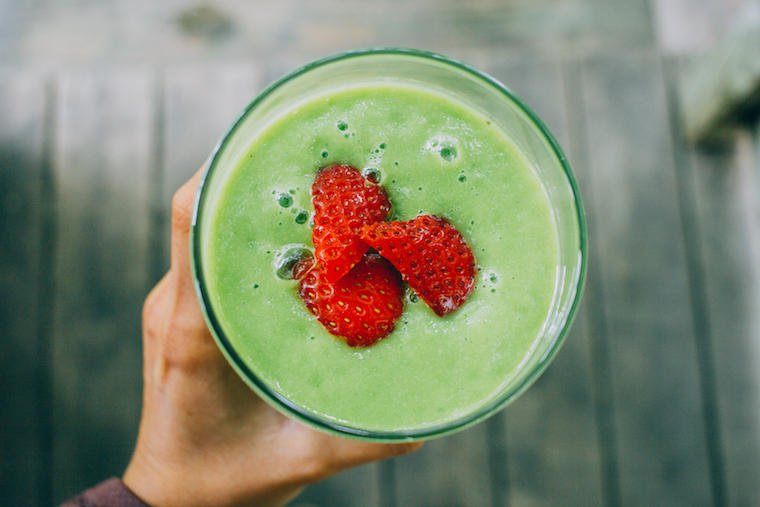
Note: This post contains affiliate links, which means that if you click through and make a purchase, I will earn a small commission at no extra cost to you. All opinions expressed are my own.


